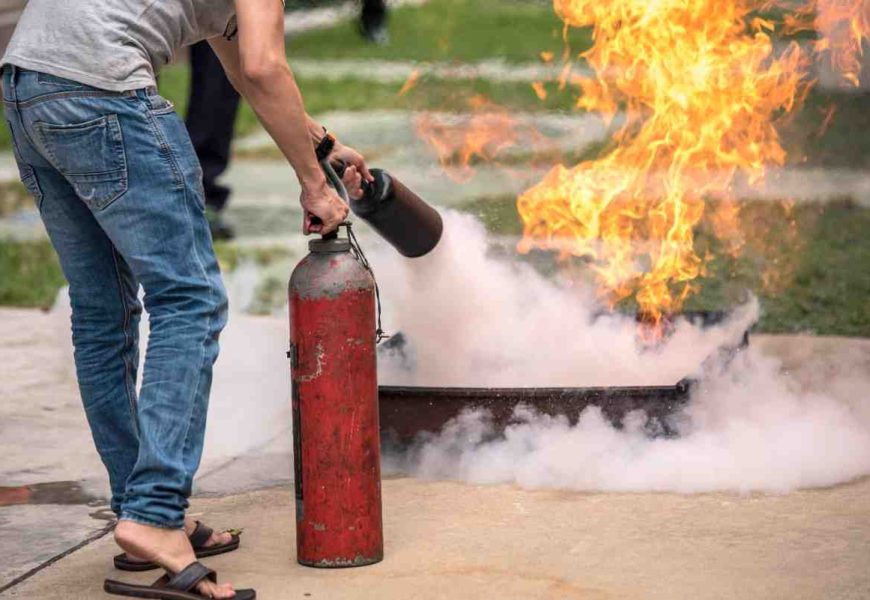Fire extinguishers have been a cornerstone of safety for over a century, evolving alongside advancements in technology, regulations, and safety awareness. As fire risks change and workplaces adopt stricter safety measures, the demand for innovative fire extinguishers continues to grow. The trends in fire extinguisher sales reflect not only technological progress but also shifting priorities in how businesses and individuals approach fire safety.
This blog explores the evolution of fire extinguishers and current trends shaping the fire safety equipment market.
1. A Brief History of Fire Extinguishers
Fire extinguishers date back to the early 18th century when British chemist Ambrose Godfrey created a basic model using gunpowder to expel fire-suppressing chemicals. Modern extinguishers, introduced in the 20th century, use pressurized gas to discharge fire fighting agents. Over time, fire extinguishers have been refined for ease of use, safety, and effectiveness.
From early models designed for general fires to today’s specialized extinguishers for electrical, chemical, and grease fires, the industry has grown to address diverse fire risks.
2. Growth in Fire Extinguisher Sales
The global fire safety market is expanding, driven by increased safety regulations and awareness. Key factors influencing the growth in fire extinguisher sales include:
- Workplace Regulations: Businesses must comply with laws mandating fire safety equipment in commercial properties.
- Rising Fire Risks: Urbanization, industrial growth, and modern infrastructure increase the need for advanced fire safety tools.
- Technological Advancements: New materials and innovations improve fire extinguisher performance and reliability.
This growth reflects a shift in how society values proactive safety measures over reactive solutions.
3. The Shift Toward Specialized Fire Extinguishers
Modern fire extinguishers cater to specific fire types, ensuring greater efficiency and safety. Examples of specialization include:
- Class A, B, C, D, and K Extinguishers: Designed for different fire risks like wood, flammable liquids, electrical equipment, metals, and cooking oils.
- Clean Agent Extinguishers: These use non-conductive, residue-free agents, ideal for sensitive environments like server rooms or labs.
- Foam and CO₂ Extinguishers: Effective for liquid fires or those involving flammable gases.
The availability of specialized extinguishers has diversified fire extinguisher sales, allowing customers to purchase tailored solutions.
4. Eco-Friendly Fire Extinguishers
Environmental concerns have influenced fire safety trends, leading to the development of eco-friendly extinguishers. These models replace traditional agents with sustainable materials that minimize harm to the environment.
Key features of eco-friendly extinguishers include:
- Reduced use of fluorocarbons and ozone-depleting substances.
- Biodegradable extinguishing agents.
- Lower toxicity, making them safer for use in populated areas.
The growing popularity of these products demonstrates the industry’s commitment to sustainability without compromising safety.
5. Technological Innovations in Fire Safety Equipment
Recent advancements in fire extinguisher technology are transforming the industry:
- Smart Extinguishers: Equipped with sensors, these devices monitor pressure levels and expiration dates, sending alerts when servicing is required.
- Lightweight Designs: Modern extinguishers are made with materials like aluminum, making them easier to handle.
- Dual-Agent Systems: These extinguishers combine multiple agents to address different fire types in one device.
These innovations not only improve the usability of extinguishers but also encourage more widespread adoption.
6. Portable Fire Extinguishers for Personal Use
Fire extinguisher sales are no longer limited to workplaces and industrial settings. Compact, user-friendly extinguishers are becoming popular for homes, vehicles, and outdoor activities.
The availability of portable extinguishers has expanded the market, encouraging individuals to prioritize personal fire safety. These products are often marketed with user-friendly instructions, ensuring accessibility for first-time buyers.
7. Fire Extinguisher Sales and Workplace Safety Standards
Businesses are increasingly prioritizing compliance with fire safety standards, driving demand for fire extinguishers. Sales representatives often serve as consultants, helping clients identify the appropriate extinguishers for their premises.
Common workplace trends include:
- Training Programs: Many suppliers offer fire extinguisher training to ensure employees are prepared for emergencies.
- Maintenance Packages: Regular inspections and servicing are bundled with purchases, ensuring compliance and functionality.
- Custom Solutions: Businesses can customize extinguishers for specific hazards, such as chemical plants or kitchens.
These practices enhance workplace safety while fostering a culture of preparedness.
8. Trends in Fire Extinguisher Distribution and Marketing
The way fire extinguishers are marketed and distributed has also evolved. Key trends include:
- Online Sales: E-commerce platforms make it easier for businesses and individuals to compare and purchase extinguishers.
- Educational Campaigns: Suppliers focus on raising awareness about fire risks and extinguisher types through blogs, videos, and training sessions.
- Bundled Safety Products: Extinguishers are often sold alongside other fire safety tools, such as smoke detectors or fire blankets.
These strategies reflect a shift toward customer-centric approaches, making fire safety more accessible.
9. The Future of Fire Extinguisher Sales
As fire safety continues to evolve, the industry is likely to see further advancements:
- AI-Powered Fire Systems: Future extinguishers may integrate with smart building systems for automatic activation and real-time monitoring.
- Expanded Global Markets: Developing countries are becoming key markets for fire safety equipment due to urbanization and regulatory changes.
- Sustainable Innovations: Continued research will likely produce more eco-friendly and effective extinguishing agents.
These trends indicate that fire extinguisher sales will remain a critical part of safety strategies worldwide.
Conclusion
The evolution of fire extinguishers highlights society’s growing commitment to safety and innovation. From specialized models to eco-friendly and smart designs, fire extinguisher sales are shaping how we address fire risks in both personal and professional settings.
By staying informed about the latest trends and investing in high-quality extinguishers, businesses and individuals can protect lives, property, and the environment. As the fire safety industry continues to advance, it’s clear that fire extinguishers will remain a vital tool in safeguarding our future.








